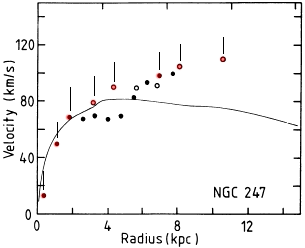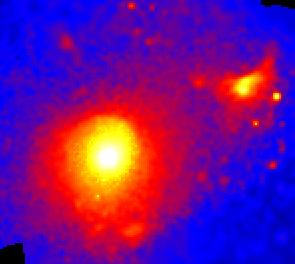7. MASSES OF GALAXIES AND CLUSTERS:
Astronomers have four basic methods to measure the masses of
galaxies and clusters: rotation curves,
random velocities, X-ray
emission, and gravitational
lensing.
Rotation curves: In astronomy,
we often infer masses from orbits. Thus, we infer the mass of the Earth by applying
Kepler's 3rd Law (as understood by Newton) to observations of the orbit of the
Moon. Likewise, we infer the mass of Jupiter from the orbits of its moons; the
mass of the Sun from the orbit of the Earth; the mass of stars from the orbits
of binary stars about each other.
By exactly the same logic, astronomers can infer the mass of
the Milky Way galaxy from the (more-or-less) circular orbits of its stars and
gas, as we described in Lesson
8. But when they did, they found that the Milky Way
has about 10 times as much mass as the mass in stars and gas that astronomers
can detect through radiation. Astronomers call this unseen matter dark
matter, and they call the ratio of dark matter to visible
matter the Mass-to-Light Ratio (M/L).
(More precisely, M/L is the mass of the system in solar units divided by its
light in solar units. Thus, the Sun has M/L = 1.) The Milky Way has M/L = 50.
Likewise, other spiral galaxies have values of M/L ranging from 5 to 50.
In fact, by measuring the rotation curves of a spiral galaxies
we can not only infer its total mass, we can infer how this mass is distributed
throughout the galaxy. This concept is demonstrated in the page Stronger
Evidence: Rotation Curves of Galaxies. Be sure to play
with the Java experiment there, and notice how the motions of the stars change
when you change the distribution of mass within the galaxy. If the mass of the
galaxy is concentrated toward its center, the interior stars move faster. (Just
as the inner planets of the solar system move faster than the outer planets.)
But if the mass of the galaxy is spread out, the orbital velocities of the stars
can actually increase with radius, as illustrated below.
|

|
|
The spiral galaxy NGC 247. The starlight is blue. The red blobs
are HII regions (hydrogen gas ionized by starlight). The yellow-green
dots are nearby stars in the Milky Way. Source: Mike
Dopita
|
|

|
|
The rotation curve of NGC 247. Solid dots; red dots are HII regions;
open circles are 21-cm radiation from neutral hydrogen (HI). The solid
curve is the rotation velocity that can be accounted for by the visible
matter alone. The data show that the outer parts are rotating faster
as a result of dark matter.
|
The most accurate method to measure the rotation curves of
galaxies is to observe the Doppler shift of the 21-cm line emitted by the interstellar
hydrogen gas with radio telescopes. We find that rotation velocities of spiral
galaxies at large distances from the center of the galaxy are much greater than
they would be if the mass were distributed in the same fashion as the luminous
stars. Indeed, we find that the dark matter in spiral galaxies must be distributed
in a more-or-less spherical shape that extends far beyond the distribution of
stars.
Random velocities: Unlike
spiral galaxies, elliptical galaxies don't rotate rapidly. The stars move in
random orbits, not circular orbits. Even so, astronomers can measure the masses
of elliptical galaxies by a technique that is similar to measuring rotation
curves of spiral galaxies. They measure the Doppler shifts of the spectral lines
of many stars to calculate average random velocities and distances from the
center of the galaxy. Then they can infer the mass of the galaxy from an equation
very similar to Kepler's Third Law. The result is similar to that for spiral
galaxies: elliptical galaxies have M/L = 5 to 50.
By exactly the same logic, astronomers can infer the masses of
clusters of galaxies by measuring average random velocities and orbital distances
of many galaxies from the center of the cluster. In fact, the first evidence
for dark matter in the universe was found by this technique in 1933 by the astronomer
Fritz
Zwicky. This method is described here,
by Curt Higgins. Rich clusters have even higher mass-to-light ratios than galaxies
-- in some cases as high as M/L = 300. That fact implies that there is more
dark matter between the galaxies in the clusters than there is in the galaxies
themselves.
X-ray emission: Another way
to infer the masses of elliptical galaxies is to observe the X-ray emitting
gas in the galaxy. Since this gas is very hot, it would naturally tend to expand
and escape from the galaxy. But it doesn't because it is bound by the galaxy's
gravity, which depends on the galaxy's mass. Therefore, by measuring the temperature
and radial distribution of the X-ray emitting gas, we can infer the mass. Actually,
the method depends on the same physical principle as the method of measuring
random velocities of stars; the main difference is that we are measuring the
random velocities of the atoms in the hot gas when we measure
the X-ray temperature. The method is described in a little more detail here,
by Robin Elliott.
|

|

|
|
Optical image of the Virgo
Cluster of galaxies. The giant elliptical galaxy M87
is the center and the giant ellipticals M84
and M86 are at the upper right.
|
X-ray image of the Virgo Cluster of galaxies, showing emission from
hot intergalactic gas around M87, M84, and M86. Source.
|
We see a fine example of X-ray emission from a cluster of
galaxies above. On the left is an optical image of the Virgo cluster of galaxies,
with the giant elliptical M87 in the center. On the right is an X-ray image
of the same cluster, showing a cloud of X-ray emitting gas centered on M87 that
is much larger than the optical galaxy. The visible M87 about 10 times as massive
as the Milky Way. By analyzing the X-ray image, astronomers can see that the
halo of dark matter around M87 has five times as much mass as M87 itself. In
the few cases where we can compare the mass of dark matter in clusters of galaxies
as inferred from the random velocities of the galaxies with that inferred from
the X-ray emission, the results agree. That fact provides a good check that
the results are reliable, at least within the error margins of the measurements
(about a factor of 2).
Up to now, the technique of measuring the masses of clusters of
galaxies through their X-ray emission has been limited by the inability of X-ray
telescopes to measure their images and spectra simultaneously. But recently
launched X-ray telescopes such as NASA's Chandra
and the European Space Agency's XMM
are far more powerful than their predecessors, so we expect soon to know a lot
more about the distribution of matter in clusters of galaxies.
Gravitational lensing: Astronomers
have found yet a third way of measuring the distribution of dark matter. That
is by measuring the deflection of light rays by gravity. This phenomenon is
described in the next section.
The most important conclusions from these studies are: (1)
galaxies and clusters of galaxies -- indeed, the universe itself -- contain
approximately 10 times as much dark matter as visible matter; and (2) the dark
matter in galaxies and clusters extends over much greater distances than the
luminous matter.
We don't know what this dark matter is. We discussed some possibilities
in Lesson 8.
But here, we see that the dark matter is everywhere, not just in the Milky Way.
As you will see, the amount and distribution of dark matter controls the evolution
of the universe -- not only the development of galaxies in the universe, but
also its ultimate fate. Therefore, understanding the nature of the dark matter
is one of the most important questions in all science.
For some more details and links to a few more excellent sites,
see Dark Matter
by Martin White.
(Return
to course home page)
Last modified March 30, 2002
Copyright by Richard McCray



